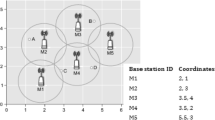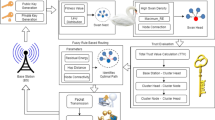Abstract
In the past, traditional wired networks have been migrated to wireless networks. In addition, the mobility and scalability in wireless networks made them suitable for many applications. One of the most important applications of wireless networks is Mobile Ad-hoc Network (MANET). MANET is defined as an infrastructure-less network, which is a self-configuring mobile nodes connected by wireless links. That means nodes in MANETs don’t need a fixed network infrastructure. Therefore, every node in MANETs works as transceiver and can communicate with other nodes directly or indirectly. They communicate with each other only if both are within the communication range. However, they rely on each other and forward packets when they are out of communication ranges. Most of the proposed MANET protocols assume that all nodes in the network are cooperative, and do not address security issues in MANETs. In open environment, the rapidly changing topology and the decentralization of nodes in MANETs, make it vulnerable for all types of passive and active attacks. On the other hand, the encryption and authentication mechanisms, which are considered as the first line of defense, are no longer sufficient to protect MANETs. Thus, Intrusion Detection Systems (IDSs) are needed to act as a second line of defense to protect the network from such security threats. The traditional wired IDSs that are designed for wired networks cannot be used in MANETs, because MANETs have different features and architecture as compared to traditional wired networks. As a result, there are many IDSs designed especially for MANETs and most of them based on the Watchdog mechanism. In this research, we propose and implement a novel IDS named Adaptive Three Acknowledgements (A3ACKs) designed specifically for MANETs. We study the behavior of the Watchdog technique, and propose a solution for its three significant problems, namely: receiver collision, limited transmission power and collaborative attacks (collusion attack), especially when there are two consecutive collaborative malicious nodes in a path. To demonstrate the feasibility of our proposed system, it is implemented and tested under various scenarios using NS2 simulator. To validate the results achieved, we compared our results with the results of some existing IDSs techniques.













Similar content being viewed by others
References
Aishwarya SA, Chawla M (2010) Detection of packet dropping attack using improved acknowledgement based scheme in MANET. Int J Comput Sci Issues 7(4):1694–1814
Akyildiz F, Su W, Sankarasubramaniam Y, Cayirci E (2002) Wireless sensor networks: a survey. Int J Comput Telecommun Netw 38(4):393–422
Al-Roubaie A, Sheltami T, Mahmoud A, Shakshuki E, Mouftah H (2010) AACK: adaptive acknowledgment intrusion detection for MANET with node detection enhancement. In: Proceedings 24th IEEE International Conference of Advanced Information Networking and Applications (AINA), pp 634–640
Anantvalee T. and Wu J (2008) A survey on intrusion detection in mobile ad hoc networks. Wireless/Mobile Security, pp 159–180
Balakrishnan K, Deng J, Varshney VK (2005) TWOACK: preventing selfishness in mobile ad hoc networks. In: Proceedings IEEE Wireless Communications and Networking (4):2137–2142
Barbeau M, Kranakis E (2007) Principles of ad-hoc networking. Wiley, New York
De Santis A, Castiglione A (2013) An intelligent security architecture for distributed firewalling environments. J Ambient Intell Humaniz Comput 4(2):223–234
Hekmat R (2006) Ad-hoc networks: fundamental properties and network topologies. Springer, Amsterdam, p 154 (eBook)
Ilyas M (2002) The handbook of ad-hoc wireless networks. CRC Press, Boca Raton
Johnson D, Maltz D (1996) Dynamic source routing in ad hoc wireless networks. Mobile computing. Kluwer Academic Publishers, Norwell, pp 153–181
Kang N, Shakshuki E, Sheltami T (2011) Detecting forged acknowledgements in MANETs. In: Proceedings IEEE 25th IEEE International Conference of Advanced Information Networking and Applications (AINA), pp 488–494
Langin C, Rahimi S (2010) Soft computing in intrusion detection: the state of the art. J Ambient Intell Humaniz Comput 1(2):133–145
Leu F, Lin C (2013) Special issue on cloud, wireless and e-commerce security. J Ambient Intell Humaniz Comput 4(2):207–208
Liu K, Deng J, Varshney PK, Balakrishnan K (2007) An acknowledgment-based approach for the detection of routing misbehaviour in MANETs. IEEE Trans Mobile Comput 6(5):536–550
Marti S, Giuli TJ, Lai K, Baker M (2000) Mitigating routing misbehaviour in mobile ad hoc networks. In: Proceedings of the 6th annual international conference on Mobile computing and networking, pp 255–265
Nandy R (2011) Study of various attacks in MANET and elaborative discussion of rushing attack on DSR with clustering scheme. Int J Adv Netw Appl 4:1035–1043
Nasser N and Chen Y (2007) Enhanced intrusion detection systems for discovering malicious nodes in mobile ad hoc network. In: Proceedings IEEE international conference on communication, pp 1154–1159
Perkins CE (2000) Ad-hoc networking. Addison Wesley Professional
Prathap U, Shenoy DP, Venugopal KR, Patnaik LM (2012) Wireless sensor networks applications and routing protocols: survey and research. In: Proceedings international symposium on challenges. Cloud and services computing (ISCOS), pp 49–56
Shakshuki E, Kang N, Sheltami T (2013) EAACK—a secure intrusion detection system for MANETs. IEEE Trans Industr Electron 60(3):1089–1098
Sheltami T, Al-Roubaiey A, Shakshuki E, Mohmoud A (2009) Video transmission enhancement in presence of misbehaving nodes in MANETs. Int J Multimed Syst 15(5):273–282
Youngho C, Gang Q, Yuanming W (2012) Insider threats against trust mechanism with watchdog and defending approaches in wireless sensor networks. In: Proceedings IEEE symposium on security and privacy (SPW), pp 134–141
Acknowledgments
The authors would like to acknowledge the support of King Fahd University of Petroleum and Minerals and Acadia University for this research work.
Author information
Authors and Affiliations
Corresponding author
Rights and permissions
About this article
Cite this article
Sheltami, T., Basabaa, A. & Shakshuki, E. A3ACKs: adaptive three acknowledgments intrusion detection system for MANETs. J Ambient Intell Human Comput 5, 611–620 (2014). https://doi.org/10.1007/s12652-014-0232-0
Received:
Accepted:
Published:
Issue Date:
DOI: https://doi.org/10.1007/s12652-014-0232-0




